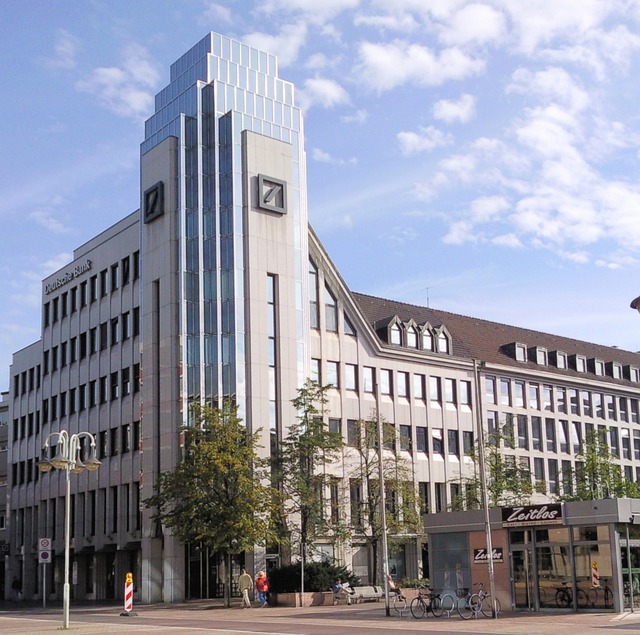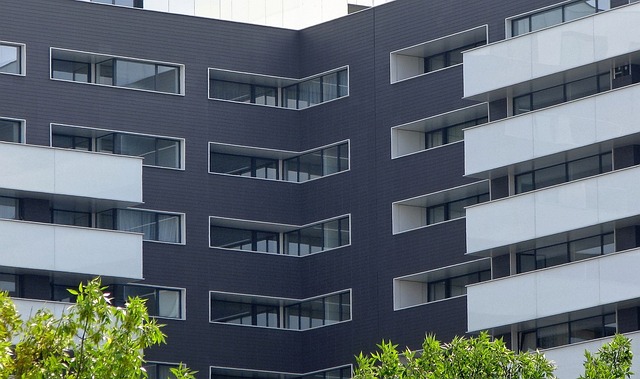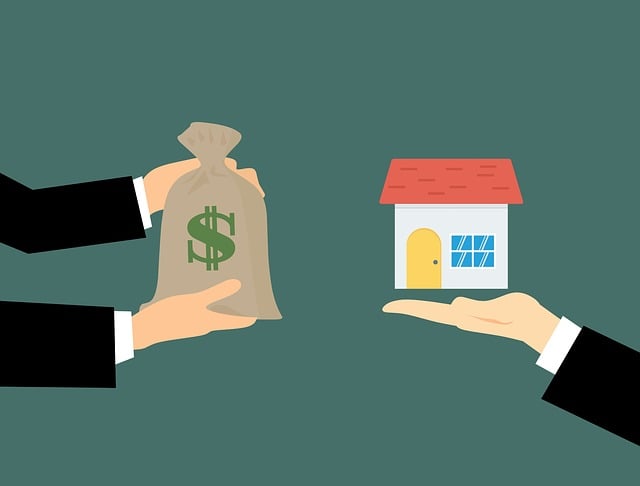Time Online: Real estate is better Price increase "inevitable": German real estate will become much more expensiveShares
House prices in Germany have risen by half since 2009. No problem so far, says Deutsche Bank in a new study. But prices are still climbing. Soon, real estate in our country will be more overpriced than anywhere else in the eurozone.
- Deutsche Bank analyzes the European housing market
- In most countries, home ownership is becoming more affordable again
- Only Germany shows worrying trend
Die Immobilienpreise in Deutschland sind nicht zu hoch. Das sagt eine neue Studie der Deutschen Bank, deren Analysten den europäischen Häusermarkt analysiert haben.
To do this, the experts compared average prices with average income. They consider the historical relationship between these two parameters to be a "fair valuation" of real estate. For Germany, the value is currently approaching this average - even though prices in this country have risen by a good 50 percent since 2009. The reason: incomes have also risen.

The trend speaks against Germany
Thus, the price increases, the study says, have merely compensated for blatant undervaluations from the previous decade time. At the beginning of the financial crisis, for example, real estate prices had slid so far that they were only a good 70 percent of the historical average.
However, the trend is against us - and clearly so. This is because the strong price increase of the past eight years will continue unabated, according to Deutsche Bank. Indeed, the study identifies a gross mismatch between supply and demand.
For example, there has been little construction in Germany for years, as also shown by a study by the Pestel Institute from Hannoverfrom November 2016. At the same time, however, more and more people in Germany need housing.
This is due to the fact that
1. since 2012, around 1.8 million net more people have moved to Germany, and
2. Around 800,000 additional students are flocking to the major cities and need housing there.
Around one million apartments will be lacking in Germany by 2020, says Deutsche Bank. Their conclusion: "Overvaluations (i.e., price increases, ed.) seem inevitable given the shortage of housing and some misguided housing policy interventions."
Because neither the influx from abroad nor the influx of capital assets to Germany is likely to slow down in the coming years, the situation will get even worse, the real estate experts warn: "That's why we expect Germany to have the highest misvaluations within the eurozone by the end of the decade."
Housing prices have doubled in Belgium and Austria
The title is currently still held by our small neighbor Belgium- ahead of our somewhat larger neighbor Austria. In both countries, real estate prices have roughly doubled since the turn of the millennium. In Belgium, they are now 140 percent of the historical average compared with citizens' incomes; in Austria, they are 125 percent.
In Frankreich, Spanienund den Niederlandenhat sich das Preisniveau zwar ebenfalls erhöht. Die drei Länder liegen aber weiterhin nur knapp hinter Österreich – und sind damit bedenklich teure Regionen.
Andere Länder haben ihre zuvor groben Überbewertungen dagegen in den vergangenen Jahren abgebaut: Irland ist von einem Niveau von 160 Prozent sogar unter seinen historischen Durchschnitt gesunken, auch in Griechenlandund Italiensanken die Preise, gemessen am Einkommen, deutlich.
Das Problem der hohen Immobilienpreise sieht die Europäische Zentralbankübrigens nicht in einer Knappheit an Wohnungen. Meistens finden Wohnungssuchende noch immer ein Heim. Die gestiegenen Kaufpreise sorgen aber dafür, dass sich immer mehr Europäerverschulden müssen. In den Niederlanden sind die privaten Haushalte etwa mit 110 Prozent des Bruttoinlandsproduktes verschuldet, in Finnlandsind es 70 Prozent. In beiden Länder haben sich die privaten Schulden seit 2001 verdoppelt.
Quelle: http://www.focus.de/immobilien/kaufen/immobilien-preise-preisanstieg-unvermeidbar-deutsche-immobilien-werden-noch-viel-teurer_id_7168655.html
Time Online: Real estate is better than shares
Over the very long term, the real return on an equity portfolio is around 7.5 percent, which is about as high as that on residential real estate. Because the latter fluctuate much less in price, they are the better investment from a risk-return perspective, at least in peacetime.
Das ist eines der überraschenden Ergebnisse eines Working Papers, das im Dezember beim amerikanischen National Bureau of Economic Research (NBER) veröffentlicht wurde. Das Papier hat das Zeug, in vieler Hinsicht durch Fakten Klarheit zu schaffen, wo es bisher nur Vermutungen gab, zum Beispiel über die langfristige Performance von Bonds, Aktien und Immobilien, oder ob die reale Rendite auf Kapitalvermögen tatsächlich auf Dauer höher ist als die Zuwachsrate des realen BIP, wie das Thomas Piketty in seinem Bestseller Le Capital au XXI siècle aus dem Jahre 2013 (deutsch 2014 “Das Kapital im 21. Jahrhundert“) behauptet hat. Eine ökonomische Theorie mag noch so elegant und überzeugend sein, wenn sie nicht zu den Zahlen passt, taugt sie nichts und muss in die Mülltonne der Theoriegeschichte.
Die fünf Autoren des Papiers (The Rate of Return on Everything, 1870-2015, NBER Working Paper No. 24112) sind Katharina Knoll von der Bundesbank, Dmitry Kuvshinov und Moritz Schularick von der Uni Bonn sowie Òscar Jordà und Alan M. Taylor von der University of California Davis. (Frei herunterladbare Version)
In the following table, I have summarized the most important results. I have only included the figures that refer to peacetime, i.e. that exclude the years of the two world wars and the immediate post-war period in each case. If you wish, however, you will also find the average values in the paper that cover these periods. I have omitted five smaller Western European countries in order not to make the table too large - but the average values refer to all the countries examined.
Source: https://blog.zeit.de/herdentrieb/2018/01/12/immobilien-sind-besser-als-aktien_10708
This is how much apartments will cost in major German cities at the end of 2020
Due to population decline, the number of city dwellers will decrease in the coming years, exceptions being the German cities with over a million inhabitants.
In many major German cities (more than 80 percent), housing prices have increased over the past ten years. Munich is the front-runner, with a 95 percent increase in the price per square meter. The reason: urbanization, living in the city is becoming increasingly popular. However, cities and regions will develop differently over the next 15 years.
This was the result of a Postbank survey of the 36 largest cities nationwide. Less than half of these cities will still grow, despite the influx of refugees. What this means for real estate prices is shown in the "Wohnatlas 2016 - Leben in der Stadt".
The population development of a city and prices on the real estate market are closely related.
For example, a one percent increase in the population causes prices for condominiums in cities to rise by an average of 3.5 percent, and for single-family homes by 1.9 percent. But the growth rates of the last ten years may soon be over.
With demographic change, the number of urban residents is also shrinking.
While two-thirds of the 36 cities surveyed have grown in the past ten years, by 2030 only two out of five will have done so - taking into account the influx of refugees. Without refugees, the figure would be just one-third.
In many cities, new fellow citizens who are granted a right to stay and thus a perspective after the asylum procedure at least mitigate the population decline.
The east in particular can benefit from the influx of refugees, while it will exacerbate bottlenecks on the real estate market in very popular cities - in both the east and the west. The study assumes that a total of around one million people will immigrate by 2030 - and that the influx will thus be roughly equivalent to the number of refugees who entered the country in 2015.
Berlin will grow the most by 2030 thanks to refugees.
Berlin to grow fastest by 2030 thanks to refugeesBerlin can expect population growth of 4.7 percent by 2030 due to the influx of refugees, putting it at the top of the list of growing cities ahead of Potsdam (4.5 percent) and Hamburg (4.4 percent). Bremen, Leipzig and Cologne narrowly escape negative population development due to refugee integration.
In Berlin, refugee numbers mean that prices for owner-occupied apartments could rise by 14.5 percent, which is more than six percentage points higher than would have been expected without the influx. In Hamburg, price increases of 13.9 percent are expected for owner-occupied apartments due to the forecast population trend. The former leader, Munich, with population growth of a good twelve percent over the past ten years, will only see an increase of 1.6 percent over the next 15 years, taking into account the expected influx of refugees.
For prices per square meter for condominiums, this suggests a population-driven increase of 4.4 percent by 2030. "Overall, prices in Munich are expected to rise more strongly, since even the rapid growth of the past fifteen years in the Bavarian metropolis is only 73 percent attributable to population growth," explains Dieter Pfeiffenberger, Divisional Board Member for Real Estate Finance at Postbank. Factors such as the development of new development areas, the expansion of the infrastructure or the settlement of large companies also influence prices.
"The influx of refugees has no direct impact on the purchase price of real estate, but it does evoke so-called cascading effects," Pfeiffenberger says.
Thus, the higher demand for affordable housing is leading to bottlenecks in the area of subsidized housing. This in turn leads to diversion effects: demand for more expensive rental apartments increases, rent levels rise and with them demand for condominiums and houses, which in turn drives up purchase prices.
*In light of the immigration of more than one million people in 2015 and the fact that 50 percent of the decided asylum applications in 2015 were recognized as refugees, the following assumptions were made for the forecast:
► About half of the refugees from 2015 receive a longer-term right to stay.
► The number of refugees decreases significantly in 2016 and the following years compared to 2015 due to political measures.
► There is further immigration via family reunification.
► Overall, immigration by 2030 is roughly equal to immigration in 2015, or one million.
► As in 2015, refugees will be distributed among the federal states according to the Königstein Key, which takes into account the number of inhabitants and tax revenue.
► The distribution of refugees within the federal states to the districts is based on population shares.
**Projected price development based on assumed population development incl. refugee influx; changes in sales price in euros per square meter
Where investments pay off
"Anyone who believes that price increases in growth cities will soon come to an end is mistaken," says Pfeiffenberger. "The study shows: Although the curve will no longer go up quite as steeply as in recent years, the upward trend is continuing. Home ownership in growth cities and their surrounding areas is therefore still a worthwhile investment. However, anyone who wants to live in their own four walls should not hesitate for too long."
According to the expert, even in cities where the population is declining, there is no need to forego home ownership: Well cut and equipped properties in attractive locations are not threatened by a loss of value here either. There could even be attractive "bargains" in these cities in the near future.
PROGNOSIS UNTIL 2030: Real estate prices to rise by up to 14.5 percent
Due to population decline, the number of city dwellers will decrease in the coming years, exceptions being the German cities with over a million inhabitants.
In many major German cities (more than 80 percent), housing prices have increased over the past ten years. Munich is the front-runner, with a 95 percent increase in the price per square meter. The reason: urbanization, living in the city is becoming increasingly popular. However, cities and regions will develop differently over the next 15 years.
This was the result of a Postbank survey of the 36 largest cities nationwide. Less than half of these cities will still grow, despite the influx of refugees. What this means for real estate prices is shown in the "Wohnatlas 2016 - Leben in der Stadt".
The population development of a city and prices on the real estate market are closely related.
For example, a one percent increase in the population causes prices for condominiums in cities to rise by an average of 3.5 percent, and for single-family homes by 1.9 percent. But the growth rates of the last ten years may soon be over.
With demographic change, the number of urban residents is also shrinking.
While two-thirds of the 36 cities surveyed have grown in the past ten years, by 2030 only two out of five will have done so - taking into account the influx of refugees. Without refugees, the figure would be just one-third.
In many cities, new fellow citizens who are granted a right to stay and thus a perspective after the asylum procedure at least mitigate the population decline.
The east in particular can benefit from the influx of refugees, while it will exacerbate bottlenecks on the real estate market in very popular cities - in both the east and the west. The study assumes that a total of around one million people will immigrate by 2030 - and that the influx will thus be roughly equivalent to the number of refugees who entered the country in 2015.
Berlin will grow the most by 2030 thanks to refugees.
Berlin to grow fastest by 2030 thanks to refugeesBerlin can expect population growth of 4.7 percent by 2030 due to the influx of refugees, putting it at the top of the list of growing cities ahead of Potsdam (4.5 percent) and Hamburg (4.4 percent). Bremen, Leipzig and Cologne narrowly escape negative population development due to refugee integration.
In Berlin, refugee numbers mean that prices for owner-occupied apartments could rise by 14.5 percent, which is more than six percentage points higher than would have been expected without the influx. In Hamburg, price increases of 13.9 percent are expected for owner-occupied apartments due to the forecast population trend. The former leader, Munich, with population growth of a good twelve percent over the past ten years, will only see an increase of 1.6 percent over the next 15 years, taking into account the expected influx of refugees.
For prices per square meter for condominiums, this suggests a population-driven increase of 4.4 percent by 2030. "Overall, prices in Munich are expected to rise more strongly, since even the rapid growth of the past fifteen years in the Bavarian metropolis is only 73 percent attributable to population growth," explains Dieter Pfeiffenberger, Divisional Board Member for Real Estate Finance at Postbank. Factors such as the development of new development areas, the expansion of the infrastructure or the settlement of large companies also influence prices.
"The influx of refugees has no direct impact on the purchase price of real estate, but it does evoke so-called cascading effects," Pfeiffenberger says.
Thus, the higher demand for affordable housing is leading to bottlenecks in the area of subsidized housing. This in turn leads to diversion effects: demand for more expensive rental apartments increases, rent levels rise and with them demand for condominiums and houses, which in turn drives up purchase prices.
*In light of the immigration of more than one million people in 2015 and the fact that 50 percent of the decided asylum applications in 2015 were recognized as refugees, the following assumptions were made for the forecast:
► About half of the refugees from 2015 receive a longer-term right to stay.
► The number of refugees decreases significantly in 2016 and the following years compared to 2015 due to political measures.
► There is further immigration via family reunification.
► Overall, immigration by 2030 is roughly equal to immigration in 2015, or one million.
► As in 2015, refugees will be distributed among the federal states according to the Königstein Key, which takes into account the number of inhabitants and tax revenue.
► The distribution of refugees within the federal states to the districts is based on population shares.
**Projected price development based on assumed population development incl. refugee influx; changes in sales price in euros per square meter
Where investments pay off
"Anyone who believes that price increases in growth cities will soon come to an end is mistaken," says Pfeiffenberger. "The study shows: Although the curve will no longer go up quite as steeply as in recent years, the upward trend is continuing. Home ownership in growth cities and their surrounding areas is therefore still a worthwhile investment. However, anyone who wants to live in their own four walls should not hesitate for too long."
According to the expert, even in cities where the population is declining, there is no need to forego home ownership: Well cut and equipped properties in attractive locations are not threatened by a loss of value here either. There could even be attractive "bargains" in these cities in the near future.
Underestimated investment: Why real estate investments even outperform stocks
"Only shares pay off as a long-term investment". This prejudice remains stubbornly in the minds of many investment advisors and investors. But there are alternatives that could outperform stock investments: Real estate.
A recently published working paper by the Federal Reserve Bank of San Francisco shows that the long-term performance of equities is by no means unbeatable. The paper is based on a study by five authors, including Katharina Knoll of the Deutsche Bundesbank. The economists examined which asset classes are most worthwhile for investors from a risk and return perspective. The result is surprising.
Return the same, risk lower
Investors want to invest their money with the highest possible return but the lowest possible risk. Leaving risk aside, stocks and real estate are the most promising ways to increase one's wealth over the long term. The real return on a stock portfolio averages more than 8 percent. Real estate investors achieve only marginally lower returns.
But there is one crucial difference: volatility. Share owners go through various phases in which their securities can fluctuate, sometimes very strongly. Even a well-diversified portfolio shows strong volatility - depending also on economic and geopolitical circumstances. Residential real estate, on the other hand, fluctuates much less in value than stocks, as the economists found in their study.
Real estate investments are thus capable of solving the dilemma faced by many investors who have to choose between return and risk. One of the authors of the study, Moritz Schularick, who is an economics professor at the University of Bonn, is convinced: residential real estate is a very lucrative Investment and relatively safe. In fact, Schularick considers residential real estate "the best investment you could make in the past 140 years from a risk-return perspective."
The expert explains why real estate is a relatively safe asset class in the event of strong price development with the special features of the real estate market. Compared with the stock market, it is less liquid. Even during a recession, rental income remains largely stable, while companies certainly have room for maneuver in dividend payments and also use this in economically more difficult times, and in the worst case scenario the distribution can even be cancelled. In addition to the relatively high resistance to crisis, real estate has another advantage, according to Schularick: "There are a number of government incentives to acquire real estate," explains the expert. In addition to state subsidies for one's own residential property, there are a number of other state allowances or tax advantages for property owners.
Ten-year record for increase: construction prices rising at a rapid pace
Especially in major German cities, the housing shortage is rampant, while at the same time building is becoming more and more expensive. In comparison to the previous year, the prices for new residential buildings are rising by more than four percent – and thus more than in ten years.
Builders have to reach deeper into their pockets. According to the Federal Statistical Office, construction prices for residential buildings climbed by 4.1 percent in May compared to the previous year. This is the strongest increase in more than ten years, said the Wiesbaden authority. The data refer to conventionally manufactured residential buildings. Prefabricated houses are not among them.
Housing construction prices had risen sharply during the previous survey in February, rising by 4.0 percent compared to the same month last year. From February to May 2018, construction prices increased by 1.0 percent according to the statistics.
In May, construction work on residential buildings was significantly more expensive than in the previous year. Here, prices rose by 4.6 percent. Prices for maintenance work – excluding cosmetic repairs – increased by 3.8 percent compared to the previous year. Driven by the low interest rates, the demand for real estate is increasing and filling the order books of the construction industry.
The prices for finishing work increased within one year by 3.6 percent. The new building prices for office buildings and commercial buildings increased by 4.1 percent each. In road construction, prices increased by 5.6 percent year-on-year. The Federal Statistical Office publishes the data on the development of construction prices every three months.
The strong increase also means that fewer and fewer Germans want to create their own home ownership. Four out of five Germans are unlikely to buy or buy housing in the next five years, according to a representative survey for the Central Real Estate Committee in June. According to this, the background is, in part, the sharp increase in purchase and construction prices in major cities and metropolitan areas.
Source: https://www.n-tv.de/wirtschaft/Baupreise-steigen-in-rasantem-Tempo-article20520268.html
Wirtschaftswoche: The duel of the century - stocks versus real estate
Since the triumphant advance of the zero-interest-rate policy of the world’s largest central banks, experts warn against high inflation. The investment recommendation has not changed over the years: real assets, assets, assets. The idea: what has an intrinsic value does not lose it. Real assets are preferable to financial assets, because inflation rises, and the prices of real assets rise. On the other hand, paper money can become worthless, financial wealth brings practically no interest and, even with low inflation, loses its purchasing power over time.
Historically, real estate is ahead
For savers and investment professionals, this strategy focuses on real estate and equities alike. No matter in which currency and at what time: Stones and land are preserved and have a value. Shares, on the other hand, are securitized ownership shares in companies; stock prices automatically take inflation into account. And in fact, both the real estate market and the stock market have been booming for years. Which system is superior?
Moritz Schularick, economics professor at the University of Bonn, together with other scientists * traced vast amounts of price and price data from 16 countries far back in time. With the data, he was able to compare the returns of equities and real estate. The result is likely to have surprised even professionals: In the nearly 150 years from 1870 to today achieved real estate a higher average yield than equities.
On average across all 16 countries, real estate gained around 7.8 percent per annum. By contrast, equities returned 6.9 percent annually. Bonds are just as far off with just under 1.5 to two percent as bank deposits with only 0.3 percent yield.
Schularick does not consider the average yield differential between equities and real estate to be serious. “The order of magnitude is similar, but of course the averages vary by country and time horizon, and France was surprised by a very low return on equities, which could be because France nationalized many large companies,” explains Schularick. Over the entire period France therefore achieved an annual return of just 2.9 percent. The return on property was significantly higher at 6.4 percent. However, since the eighties, the picture is quite different: 5.8 percent real estate return compared to 8.3 percent equity return in France.
Distinct differences in the countries
The results for Germany differ slightly. For example, real estate prices in this country have been able to grow by around 7.9 per cent over the entire period, and share prices have dropped by one percentage point less per year. It is interesting, however, that since 1950, the stock return in Germany exceeds that of the real estate. The difference is particularly clear from 1980 onwards. On average, real estate prices have risen by only 4.1 percent since 2015, while equities dropped a good ten percent of their return per annum.
The fact that real estate in any case bring in more return than stocks, so the study may not be so easy to be closed. For example, Schularick talks about a “hockey stick” in the historical development of real estate prices. This means that the real estate price curve is initially flat, as it was for a hockey stick – over many decades – but has been rising steeply since the mid-20th century. Schularick attributes this primarily to rising real estate prices, which benefited from the dramatic drop in transport costs due to rail and steam shipping. As a result, this ensured that remote areas for the economy and population could be developed. Also the destruction in the course of the world wars let the real estate requirement rise strongly.
The high real estate yields are not a natural law, but a still young development. For example, the researchers found that Australia historically has the highest real estate yields. Germany, on the other hand, is more likely to find itself at the bottom. In this country, for example, real estate prices hardly moved in the two decades before the start of the most recent real estate boom in 2010. In the US and Spain, however, real estate bubbles burst during this time, house prices plunged massively. Billions in assets were lost there.
Source: https://www.wiwo.de/finanzen/geldanlage/renditevergleich-das-jahrhundertduell-aktien-gegen-immobilien/19587708.html
Less square meters per person: City dwellers live somewhat more cramped - n-tv.de (n-tv.de)
Since reunification, the average living space per capita has grown steadily - but this trend is now history, especially in the big cities. Because rents have exploded, some people are living in smaller spaces. The situation is quite different for homeowners and retirees.
The sharp rise in prices on the real estate market in many places has noticeably slowed the long-term trend toward larger apartments. Among renter households in major cities, the average living space per capita even declined over the past decade, according to a study by the Institute of the German Economy (IW). "Never in recent history have people spent so much time in their own four walls as during periods of lockdown," the study said. But calculations by the IW based on the socio-economic panel showed large differences in the distribution of living space.
According to the study, owners live in 125-square-meter apartments on average, while tenants live in 75-square-meter apartments - 48 square meters per capita for owners and 35 square meters for tenants. According to the study, the average living space per capita in Germany has increased by 34 percent since 1990. Since the start of the real estate boom in 2010, however, the increase has slowed noticeably. This is mainly due to the development among tenants, the IW reports. Here, the average living space per capita has stagnated since 2010. In major cities, it is even falling.
At the same time, the proportion of tenants who have less than one living space per household member is again growing significantly, having previously declined for a long time. Among homeowners, on the other hand, the amount of living space has continued to rise significantly. According to the study, in the overall population, living space of more than 41 square meters per capita already places people in the top 50 percent, and 83 square meters per capita and more places them in the top 10 percent.
Trends such as migration, urbanization and demographic change are clearly reflected in the real estate market, according to the study. The proportion of single-person households rose from 34 to 42 percent between 1990 and 2018, according to the IW, which is close to employers. Three-quarters of all households now have a maximum of two people living in them. Households with three or more people, on the other hand, had lost relevance for the housing market. The proportion of tenants with a migration background rose from 25 to 32 percent between 2010 and 2018.
While the differences between different income groups are quite small, they are all the greater between migrants and people without a migration background: on average, people with a migration background have 30 square meters available per capita, while people without have 45 square meters. Elderly people have the most space: on average, a pensioner in Germany has 60 square meters of living space.
The aging of society is also reflected in the data. In 2018, more than 40 percent of owner households were older than 65 - up from just 27 percent in 2000. The share of owner households under 45 years old halved to just 15 percent over the same period.
Source: https://www.wiwo.de/finanzen/geldanlage/renditevergleich-das-jahrhundertduell-aktien-gegen-immobilien/19587708.html
Rent cap? Living cheaply in the office? Government powerless against rent-seeking - FOCUS Online
Merkel powerless against rent-seeking: Do empty offices solve German housing shortage?
Rents are rising inexorably in major cities. Even buying a home in sought-after locations is becoming unaffordable for most. Too little new housing is being built. Things are getting tight. Even after the German government's housing summit, the issue remains a construction site. Can the Corona pandemic, of all things, bring a solution?
Wer in München nicht mehr als 30 Prozent seines Einkommens in eine durchschnittliche Wohnungsmiete stecken will, sollte mehr als 105.000 Euro brutto im Jahr verdienen. In Frankfurt am Main und Stuttgart kommt man hier schon mit gut 80.000 Euro Jahresverdienst an eine Wohnung, in Heidelberg rund 70.000 Euro.
FOCUS Online had examined in January, how much money you must earn in each case, in order to rent an apartment of 68 square meters in a region and spend for the rent not more than 30 percent of your income. According to the Federal Statistical Office, singles currently live in an average of 68 square meters. For some dual-income couples, rent may not be a problem, and some will have to spend a higher proportion of their household income, but for most single earners, rent will remain unaffordable in Germany's major cities.
Und die Belastung für den Mieter nimmt unaufhaltsam zu: Die deutsche Mietwohnung wird von Jahr zu Jahr teurer. Die Preise für Häuser und Wohnungen steigen in den meisten Regionen Deutschlands seit Jahren unaufhörlich. In der Folge wird der Wohnungskauf daher immer attraktiver. Wer kauft statt mietet, spart deutschlandweit im Schnitt 48,5 Prozent, so das Ergebnis einer Studie des Instituts der Deutschen Wirtschaft (IW) aus Köln. Mit anderen Worten: Eigentümer zahlen fast 50 Prozent weniger als Mieter fürs Wohnen. In Köln sind es sogar fast 60 Prozent. In 90 Prozent der 401 vom IW untersuchten Kreise und kreisfreien Städte schlägt Eigentum die Miete.
Und so steigen wegen der hohen Nachfrage nach Wohneigentum und der niedrigen Bauzinsen auch die Kosten fürs Eigenheim. Nach Berechnungen des Baufinanzierers Interhyp stieg der durchschnittliche Kaufpreis einer Immobilie inklusive Nebenkosten von durchschnittlich 277.000 Euro im Jahr 2010 auf 434.000 Euro im 1. Halbjahr 2020 – ein Plus von 56,7 Prozent.
Conclusion: There is too little living space in Germany. The price spiral is spiraling ever higher.
Lesen Sie zum Thema auch: Hohe Preisunterschiede je nach Region – So viel Haus können Sie sich als Durchschnittsverdiener in Deutschland leisten
Social housing in retreat: too little housing for the poor
Bauminister Horst Seehofer (CSU) sieht die Bundesregierung bei der „Wohnraumoffensive“ hingegen auf dem richtigen Weg. Bei einer Bilanzveranstaltung in Berlin versichert er, bis zum Ende der Wahlperiode werde das selbstgesteckte Ziel von 1,5 Millionen neue Wohnungen erreicht. Die noch fehlenden Baumaßnahmen sollen noch im Laufe dieses Jahres auf den Weg gebracht werden.
Seehofer: "Last year alone, 300,000 homes were built despite the Corona pandemic. That's the highest level in 20 years." He added, however, that the end of the road is not yet reached in addressing the housing shortage: "We still have a lot of work to do."
Zum Start der im Koalitionsvertrag festgeschriebenen „Wohnraumoffensive“ vor knapp zweieinhalb Jahren hatte Seehofer insgesamt 1,5 Millionen neue Wohnungen versprochen. Bis Ende des Jahres werden es wohl 1,2 Millionen. Zusätzlich rechnet das Bauministerium mit etwa 770.000 Baugenehmigungen. Der Bund gebe für den sozialen Wohnungsbau eine Milliarde Euro pro Jahr aus, betont auch der Koalitionspartner der Union, die SPD. Man habe das Wohngeld angepasst, das Baukindergeld eingeführt und Sozialwohnungen gebaut – „auf hohem Niveau“.
For example, although more than 25,000 social housing units were built nationwide in 2019, at the same time nearly 65,000 units fell out of the social housing obligation. The bottom line is that there were fewer social housing units. For the IG Bau trade union, the offensive has therefore failed. "In terms of housing construction, the transfer is at risk for this federal government," said IG Bau head Robert Feiger. The rents went through the roof, while every twelve minutes a social housing disappears from the market. According to IG Bau, rents for simple apartments for Hartz IV recipients, for which the state bears the costs, have risen by 28 percent on average in Germany since 2015.
In the opinion of Katrin Göring-Eckardt, head of the Green Party parliamentary group, the housing policy of the grand coalition of CDU, CSU and SPD is also not bringing any progress: "The government's record is devastating: exploding rents, dwindling social housing, hardly any affordable property for families in conurbations, plus more vacancies and desolate town centers." According to Göring-Eckardt, the explosion of rents is one of the most pressing social problems in the country: "The federal government has not managed to alleviate the housing shortage in our cities, it has even exacerbated it." Furthermore, far too many social housing units were lost. "Horst Seehofer could have prevented this social robbery with a new law that permanently secures social housing."
Der baupolitische Sprecher der SPD-Fraktion im Bundestag, Bernhard Daldrup, will die Vorwürfe der Grünen nicht auf sich und der Koalition sitzen lassen: „Kritik und Forderungen der Grünen in Berlin stimmen mit ihrem Handeln in Ländern und Kommunen nicht überein. Immerhin sind die Grünen in elf Bundesländern an der Regierung beteiligt und ebenso in zahlreichen Kommunen politisch verantwortlich.“
Solutions needed - not only for metropolitan areas
But political wrangling and playing the blame game doesn't help people. And when it comes to construction and housing, it's not just about the major metropolitan areas, but also about inner cities and village centers. There, apartments are often vacant, and sometimes houses are falling into disrepair. In order to make town and village centers more attractive, CSU Member of Parliament Emmi Zeulner, for example, proposes locating universities and university chairs in rural regions, making the protection of historical monuments flexible and increasing tax depreciation. Zeulner is the rapporteur for the CDU/CSU parliamentary group in the Building Committee: For Zeulner, locating universities in rural areas has several advantages: "Not only will existing university locations be relieved, but at the same time we will use this to provide targeted growth impulses in rural areas."
But to make rural areas more attractive, they also need more up-to-date infrastructure, such as broadband Internet, rail connections, more shopping facilities or hospitals and specialists - and of course jobs. As long as there is a shortage of the bare essentials in rural areas, people will continue to move to the cities.
Und dort beklagen etwa der Eigentümerverband Haus und Grund und sein Präsident Kai Warnecke eine bloße Mangelverwaltung. Es gebe zu wenig Anreize zum Neubau von Eigenheimen und Mietwohnungen. Vermieter würden durch Vorgaben und Gesetze belastet, so Warnecke. Es müsse sich lohnen, Wohnraum anzubieten. Die Rendite privater Vermieter in Deutschland liegt nach Angaben des Verbands zwischen ein und zwei Prozent: „Die Objekte werden gekauft von denjenigen, die mit ihnen spekulieren wollen“, sagt Warnecke: „Sie haben keinen Bezug mehr zum deutschen Wohnungsmarkt.“ Rhetorisch fragt er: „Wer soll in Zukunft Ihr Vermieter sein? Der Bürger von nebenan oder der Fonds auf den Cayman Islands?“
Home office creates space: Converting empty offices into apartments?
Möglicherweise könnte ausgerechnet die Corona-Pandemie die Wohnungsnot in den Städten lindern. Denn wegen des derzeitigen Trends zum Home-Office steht in den Städten massenhaft Büroflächen leer. 325.000 Wohnungen könnten so in den kommenden vier Jahren neu entstehen, wenn man die Büros in Wohnungen umbauen würde. Das ist das Ergebnis zweier Studien des Eduard-Pestel-Institutes aus Hannover und der Arbeitsgemeinschaft für zeitgemäßes Bauen aus Kiel errechnet. Zum Vergleich: Im Jahr 2019 lag die Zahl der fertiggestellten Wohnungen bundesweit bei 293.000.
The studies were commissioned by the "Social Housing" alliance of associations, which includes the German Tenants' Association, Caritas, the Construction, Agricultural and Environmental Workers' Union, the German Society for Masonry and Housing Construction as the umbrella organization of the masonry brick industry, and the German building materials trade. And they associate the figure with clear political demands. There must be a "strict social quota" for the additional apartments so that office buildings do not become luxury lofts. In addition, the state would have to set up a special program to promote the conversion.
But whether there are actually so many vacant office spaces that are no longer needed is debatable. The idea has charm, however, because it could help not only to alleviate the housing shortage but also to strengthen city centers. But the Institute of German Business (IW) recently found in a survey that only 6.4 percent of companies in Germany plan to reduce their office space. So so far, more home office does not mean that offices are already being freed up on a larger scale. And in sought-after metropolitan areas such as the Stuttgart region, there is more likely to be too little office space than too much. According to a study, the vacancy rate in the state capital was only two percent in the fall. And rents have not been depressed by the Corona pandemic, the real estate analysis company Bulwiengesa has determined on behalf of the city of Stuttgart and the Stuttgart Region Economic Development Corporation. In addition, retrofitting office space with kitchens and sanitary facilities is extremely costly.
Rent cap demanded for the whole of Germany
That leaves the controversial rent cap from Berlin. Could it be the panacea for German tenants' stretched wallets? According to an alliance of trade unions, tenants' associations and social welfare organizations, Germany has no other choice. They are calling for "Rent freeze! Because your home is at stake." If it were up to the alliance, rents should be frozen at their current level nationwide for six years.
Adolf Bauer, President of Sozialverband Deutschland (SoVD): "Although the development of rents affects everyone equally, it makes poor people in particular even poorer. Single parents, pensioners and people with a migration background are particularly disadvantaged, as are single households and recipients of transfer payments." Bauer wants more subsidies and stronger market regulation: "Only more public housing subsidies, more social housing construction and more prudent building land mobilization can prevent speculation and promote affordable housing."
Doch in Berlin – dem Vorreiter in Sachen Mietendeckel – hat das Einfrieren der Mieten für bizarre Verhältnisse auf dem Wohnungsmarkt gesorgt. Zwar sanken laut einer Analyse von ImmoScout24 zwischen September 2019 und September 2020 die Angebotsmieten für die vom Mietendeckel betroffenen Wohnungen um fünf Prozent von durchschnittlich 12,91 auf 12,26 Euro pro Quadratmeter. Gleichzeitig verringerte sich das Gesamtangebot an Mietwohnungen in Berlin jedoch massiv um 41,5 Prozent. Das Angebot von Bestandsmietwohnungen sank sogar um 59,1 Prozent.
Dass der drastische Angebotsmangel in Berlin nicht durch die Corona-Pandemie hervorgerufen wurde, zeigt ein Blick auf die anderen Top-Metropolen in Deutschland. Denn in Hamburg, Düsseldorf, Frankfurt am Main, Köln, München und Stuttgart hatte das Wohnimmobilienangebot auf ImmoScout24 im gleichen Zeitraum anders als in Berlin deutlich zugenommen. So stieg in diesen Top-6-Städten das Gesamtangebot an Mietwohnungen im gleichen Zeitraum um 35,3 Prozent.
Landlords in Berlin are hesitant to relet because of the rent cap. Many prefer to sell their apartments. The Federal Constitutional Court wants to rule on the admissibility of the rent cap by June.
Vienna and Amsterdam can become models for major German cities
So bleibt es wohl noch für einige Zeit beim jahrzehntelangen Trend, sich ins Umland der Städte abzusetzen und zwischen Heim und Arbeitsplatz zu pendeln. Doch die so entstandenen Pendlerströme führen mittlerweile in vielen deutschen Großstädten zum Verkehrskollaps. Es fehlt vielerorts an Bahnanbindungen und dem Ausbau des öffentlichen Personennahverkehrs. Abhilfe würde wiederum günstiger Wohnraum in den Städten schaffen. Und so beißt sich die Katze wieder in den eigenen Schwanz.
Many urban planners therefore advocate the large-scale purchase of apartments by local authorities. This is the only way to prevent rent increases and real estate speculation in cities. As early as the 1920s and 1930s, Vienna promoted housing cooperatives and built tens of thousands of municipal apartments. And even today, there are 220,000 apartments owned by the city of Vienna. Vienna has thus removed a large part of its real estate supply from the speculative real estate market.
Architect and urban planner Steffen de Rudder of Bauhaus University Weimar: "60 percent of people live in Vienna in municipally subsidized housing. That's great. In Amsterdam, it's similar. The city owns large housing projects and can control more. In many German cities, that has been out of hand. But what also shows: The housing issue is mainly a matter of politics, less of urban development."











